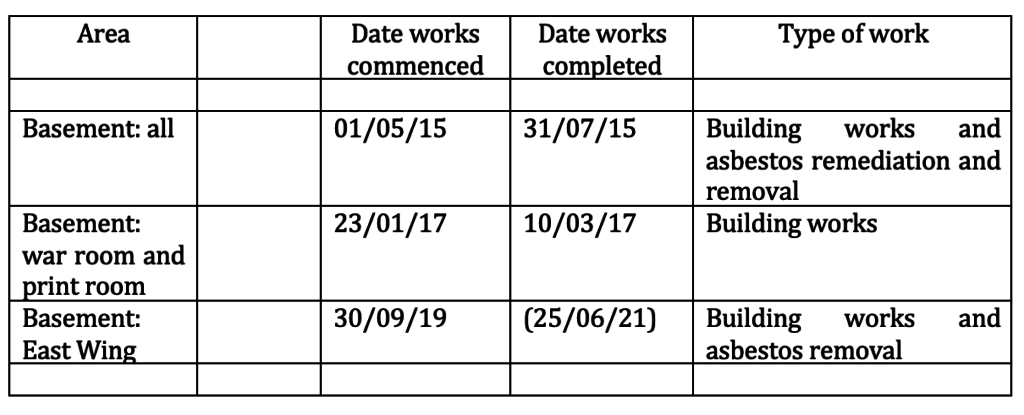Has LBWF come clean about Town Hall asbestos to its employees, as the law demands? The evidence suggests not, and that’s a serious matter
As Director of Governance and Law Mark Hynes’ asbestos management investigation limps into its seventh month, so far without any tangible findings, it becomes ever more obvious that one of the major obstacles to him reaching completion is the absence of key evidence that would prove LBWF complied with the law.
One revealing illustration of this is some recently unearthed revelations about how LBWF has communicated about asbestos with its employees.
All employers have a responsibility to consult their employees over health and safety matters under the Safety Representatives and Safety Committees Regulations 1977, and the Health and Safety (Consultation with Employees) Regulations 1996, but those managing asbestos are subject to further direction from the Health and Safety Executive (HSE), the national regulator.
For example, the latter’s A comprehensive guide to Managing Asbestos in premises (HSG227), first published in 2002 and now freely available online, advises: ‘It is important to communicate with employees throughout the asbestos management process, from inspection of the premises through to the decision-making about management of your ACMs [asbestos-containing materials]’.
Equally pertinent, the HSE’s Managing and working with asbestos of 2013, which sets out employers’ legal duties under the bedrock legislation, the Control of Asbestos Regulations 2012, instructs that each organisation must have a written asbestos management plan, and underlines that this, along with any risk assessments which are carried out prior to remedial work, should be communicated to employees.
That’s clear enough, but can LBWF be shown to have conformed?
An example is indicative.
It had long been known that the Town Hall basement was beset by more asbestos issues than any of the other floors in the building, and so in the years after 2015, it was a priority for attempted remediation which, responding to a Freedom of Information Act (FIA) inquiry, LBWF now itemises as follows:
Yet when asked, also under the FIA, for ‘the minutes of meetings with the Town Hall trade unions where these three periods of building work were discussed’, LBWF answers ‘Unfortunately Council [sic] does not hold the information you have requested’.
As to direct (i.e., management to staff) communication, what LBWF describes as ‘correspondence to employees regarding asbestos works taking place in the basement between 2015-2020’ turns out to consist of just four documents:
1. Excerpt from ‘YourNews’, dated 22 May 2015, headed ‘Scheduled Maintenance Work’, and advising that ‘a project to remove…ACM…from the basement boiler room’ will occur from 26 May to 23 June, and be accompanied by access closures, with a link provided to ‘a full briefing’.
2. Excerpt from ‘Your News’ dated 29 May 2015, headed ‘This week’s Management Board Blog comes from…Daniel Fenwick, Director, Governance’, which deals with ‘the court proceedings around the handling of asbestos at the Town Hall basement between 2002 and 2012’; emphasises ‘We have worked with the HSE to make sure that nothing like this happens again in future’; and ends by encouraging ‘anyone who is concerned or considers that they were put at risk by visiting or working in the basement, to contact the Health& Safety Team…and complete an Incident Report Form…[which] will be kept on record by the Council’.
3. Excerpt from ‘[LBWF CEO] Martin Esom’s Blog’, dated 2 June 2015, which deals with a number of other subjects before noting: ‘Finally, I also wanted to mention that last week the Council was fined after pleading guilty to charges relating to the handling of asbestos in the Town Hall between 2002 and 2012. The Council has fully accepted that more should have been done in the past to manage the safety of our buildings, and we have worked with the Health and Safety Executive to ensure that nothing like this happens again in future. If you have any concerns or would like further details about this please see Daniel’s blog from Friday’.
4. ‘A Message from Martin Esom, requiring action’, dated 11 July 2018, which reads:
‘Morning All
Property and Asset Management have requested that this information is cascaded to all staff. Please ensure that this is actioned.
In order to ensure staff safety during the next phase of asbestos works in the basement access will be restricted.
Anyone wishing to enter the area should request access from the Facilities or Capital Delivery Teams and will be escorted.
The people to contact for access are below…
Please feel free to contact either of the above if you have any queries or require further clarification.
Many thanks
Martin’.
This correspondence in itself is disconcertingly thin, but more striking still is the fact that it contains nothing about some important matters, including for example:
(a) the risk assessments that should have been completed before the three periods of building work started;
(b) the annual asbestos surveys which occurred during these years, and were important not least because they updated the Town Hall asbestos register, and so the related management plan; and
(c) a number of key events, such as
(i) the 2017 basement building work in its entirety;
(ii) the incident in early 2020 when a staff member made a complaint directly to the HSE, which the latter summarised thus:
‘Drilling in the basement is causing a lot of brick dust to go out throughout the buildings, so much that it is setting off the fire alarms; and
With the presence of asbestos in the basement, there is a risk to possible exposure to asbestos particles in the brick dust produced by the drilling’; and
(iii) the very detailed refurbishment survey of September 2020 which confirmed once again that ACMs were to be found across the Town Hall basement, sometimes ‘exposed’ on walls and ceilings, sometimes in ‘debris’ on the floor, with 17 locations classified as ‘high priority/risk’ and 66 classified as ‘medium priority/risk’.
All told, then, though LBWF has on occasion since 2015 communicated with employees about asbestos management, it seems never to have lived up to the requirements demanded by the law.
From this perspective, it is easy to see why Mr. Hynes may be in something of a quandary.
However, happily, Mr. Hynes is not completely without advantage, because he is not only ‘supported’ by an external legal team plus a prominent barrister, but also has an expert witness to hand, no less than his boss, Mr. Martin Esom, who of course is both the Statutory Duty Holder (i.e., person with ultimate legal responsibility) for all LBWF asbestos matters, and an HSE board member, meaning that, after a conversation with himself in a darkened room, he will be well placed to offer the most helpful of advice.

